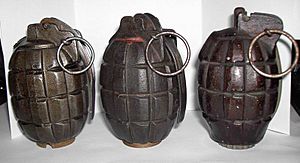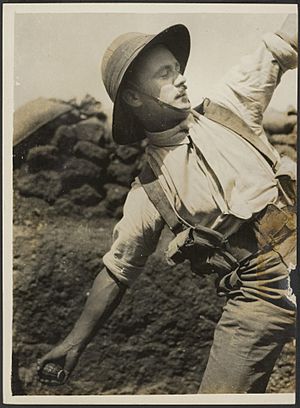Mills bomb facts for kids
Quick facts for kids Mills bomb |
|
|---|---|

Mills bombs. From left to right : No. 5, No. 23, No. 36
|
|
| Type | Hand grenade |
| Place of origin | United Kingdom |
| Service history | |
| In service | 1915–2021 |
| Production history | |
| Designed | 1915 |
| No. built | over 75 million |
| Variants | No. 5; No. 23 Mk I, II and III; No. 36 Mk I; No. 36M Mk I; No. 36 Mk II |
| Specifications | |
| Mass | 765 g (1 lb 11.0 oz) |
| Length | 95.2 mm (3.75 in) |
| Diameter | 61 mm (2.4 in) |
|
|
|
| Filling | Baratol |
|
Detonation
mechanism |
Percussion cap and time delay fuse: 7 seconds, later reduced to 4 |
The Mills bomb is the well-known name for a type of hand grenade created in Britain. These grenades were designed by William Mills. They were the very first modern fragmentation grenades used by the British Army. They were used a lot in both the First and Second World Wars.
Contents
How the Mills Bomb Was Developed
William Mills, who designed hand grenades, created the "Mills bomb" in 1915. He made it at his factory in Birmingham, England. The idea for the Mills bomb came from an earlier design by a Belgian captain named Leon Roland. The British Army started using the Mills bomb as its main hand grenade in 1915. It was called the No. 5.
Changes and Improvements to the Design
The Mills bomb was changed many times over the years.
- The No. 23 was a No. 5 grenade that could be fired from a rifle. It had a special base for a rod.
- The No. 36 was an even more improved version. It had a base that could be taken off to be used with a special cup on a rifle.
- The No. 36M was the final version. It was made waterproof with a special coating called shellac. This was done so it could be used in hot, wet places like Mesopotamia. This version stayed in production for many years.
By 1918, the No. 5 and No. 23 models were no longer used. The No. 36 (but not the 36M) was also stopped in 1932.
How the Mills Bomb Worked
The Mills bomb had a classic design. It looked like a "pineapple" because it had grooves on its cast iron body. It had a central pin that was held by a lever, which was secured with a safety pin. The grooves on the casing were actually there to make it easier to hold, not to help it break apart into pieces.
The Mills bomb was a "defensive" grenade. This means it was meant to be thrown from a safe place, like behind a wall, at an enemy out in the open. It would wound people with its flying pieces (fragments). An "offensive" grenade, on the other hand, doesn't break into many pieces. It uses a short-range blast effect to hurt or stun without putting the person throwing it in danger from fragments. Even though they had these names, both types of grenades were often used in different ways.
A good thrower could throw the grenade about 49 ft (15 m) accurately. However, the deadly fragments could fly much farther than that. The British Home Guard was told that the No. 36 could be thrown about 30 yd (27 m), but its danger area was about 100 yd (91 m).
Fuse Time Changes
At first, the grenade had a fuse that took seven seconds to explode. But during the Battle of France in 1940, this delay was too long. It gave enemies enough time to run away or even throw the grenade back! So, the delay was made shorter, down to four seconds. The British Army still used grenades with a seven-second fuse for those fired from rifles, as the longer time was needed for the grenade to reach its target.
After the Second World War, Britain started using newer grenades. These had smooth metal casings with coiled wire inside, which made the fragments spread more evenly. The No. 36M Mk.I was the main grenade for the British Armed Forces until 1972. It was replaced by the L2 series. Mills bombs were still used in some parts of the world, like India and Pakistan, until the 2000s. India was the last major user of the Mills bomb, finally replacing it in August 2021.
Different Models of the Mills Bomb
- The No. 5 Mk 1 was the first version. It was filled with explosive through a small hole. The detonator was put in through the bottom. A safety pin held the lever down. It was first given out in May 1915 and became widely available in 1916.
- The No. 23 Mk 1 could be used as a hand grenade or fired from a rifle. It had a special hole in its base for a rifle rod. The No. 23 Mk II had a new base that was easier to tighten. The No. 23 Mk III had a new body with a bigger filling hole.
- The No. 36 Mk. 1 was introduced in May 1918. It used the No. 23 Mk III body with a new base. It was mostly made of iron. It could be fired from a cup attached to a rifle's muzzle using a blank cartridge.
- The No. 36M Mk I was coated with shellac to protect it from moisture and humidity. This was important for use in places like Mesopotamia. The No. 36M Mk I was the main hand grenade for the British army from the 1930s until 1972.
How to Identify a Mills Bomb
- A green band around the middle first meant it was filled with Amatol. Later, it meant it had Baratol or Trotyl inside.
- A pink band around the middle meant it had Ammonal or Alumatol. Alumatol is a mix of ammonium nitrate, TNT, and a small amount of aluminum powder.
- A red band around the base plug (at the bottom) meant the detonator was already in place, and the grenade was ready to be used.
- Three red X's along each side showed that it was the waterproofed No.36M model.
Mills Bomb as a Rifle Grenade
The Mills bomb was also made into a rifle grenade by adding a metal rod to its base. This rod-type rifle grenade could hit targets about 150 yards (140 m) away.
How to Fire a Rod-Type Rifle Grenade
To fire it, a soldier would:
- Put the rod of the Mills bomb down the barrel of a standard rifle.
- Load a special blank cartridge into the rifle.
- Place the rifle's stock (the back part) on the ground.
- Pull the Mills bomb's safety pin, which would release the safety lever.
- Immediately fire the rifle.
It was very important for the soldier to fire the rifle quickly. If they didn't, the grenade's fuse would run out, and it would explode too soon! A simple holder was later added to the rifle's bayonet lug to keep the safety lever in place and prevent accidental explosions.
However, firing these rod-type grenades often damaged the rifle's barrel. The heavy grenade and rod caused too much pressure inside the barrel, making it bulge.
The Cup-Type Launcher
Because of the damage caused by the rod-type grenades, the British then developed a cup-type launcher. This launcher looked like a can and was attached to the muzzle (the front end) of the rifle. A special metal disc was screwed onto the base of the grenade before it was placed in the cup.
With the cup launcher, the safety pin could be removed because the cup held the safety lever in place. The soldier would load a blank cartridge, then angle the rifle on the ground to absorb the kickback (recoil). When the cartridge was fired, it pushed the grenade out of the cup, releasing the lever. This cup-type launcher could launch the grenade about 200 yards (180 m). Sometimes, copper wire was wrapped around the rifle's stock to stop the wood from splitting from the strong recoil.
Both the rod and cup grenades could still be thrown by hand if needed. The cup launcher was mostly given to the British Home Guard, not the regular British Army.
Gallery
See also
- Kugelhandgranate
- F1 grenade (France)












